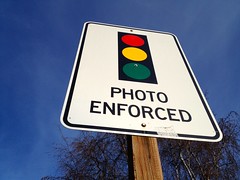
Red light cameras have never been popular with people who drive. Since their introduction in to the US, many states have banned their use entirely. Various automobile associations and motoring groups have steadily campaigned for their removal by claiming that they do little for safety and only serve to line the pockets of cities and the private companies often behind the cameras themselves. It comes as no surprise, then, that the City of Auburn recently joined a growing number of cities across the country by choosing to remove the red light cameras installed at four intersections across the suburb. The move was undoubtably popular with local citizens, and council members voting for the removal cited data indicating that the cameras had failed to reduce injuries or automobile collisions at their intersections. On the other hand, the cameras did appear to reduce the number of people running red lights.
With Auburn out of the red light camera business, the question of Seattle following suit has come up. Like Auburn, Seattle first installed its cameras in an attempt to reduce collisions and improve safety at various high risk intersections. Unlike Auburn, though, data shows that Seattle’s red light cameras have done a tremendous job of reducing the number of collisions at various intersections across the city. By looking at the number of collisions in the three years before and three years after a camera was installed, Seattle Department of Transportation (SDOT) has found that red light cameras have reduced accidents by about 23% on average. Right angle collisions (also known as t-bone or broadside collisions) were reduced by a whopping 46%, while collisions involving a person walking were reduced by nearly one-third.
Correlation, of course, is not proof of causation–but it is a hint. The data has some imperfections, as well: in some instances a camera had to be tuned off for construction, while in others poor intersection design caused additional collisions. Not every intersection equipped with a camera saw an improvement, either. But even with these issues, the difference is stark and lends credence to the assertion that red light cameras can help make intersections safer.
To help show just how effective red light cameras in Seattle have often been, I’ve created an interactive visualization based on the data that SDOT provided The Urbanist. Use the dropdown or click on the map to look at how different intersections stack up in the overall dataset. SDOT’s data includes a total of all collisions at an intersection in the three-year periods before and after a red light camera was installed, along with the specific amounts of pedestrian, rear end, and right angle collisions (which may not add up to the total). Click here to view a bigger version, and note that you can download the file if you want to dig in further.
Will became inexplicably interested in city planning, design, and urbanism after growing up in mostly-suburban Ohio. After spending 5 years living in Seattle's Rainier Valley, he relocated to San Francisco's Tenderloin neighborhood along with his wife and cat.



